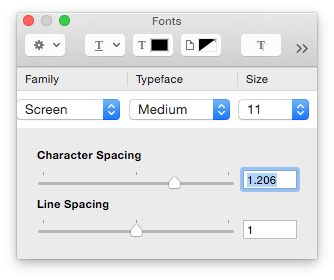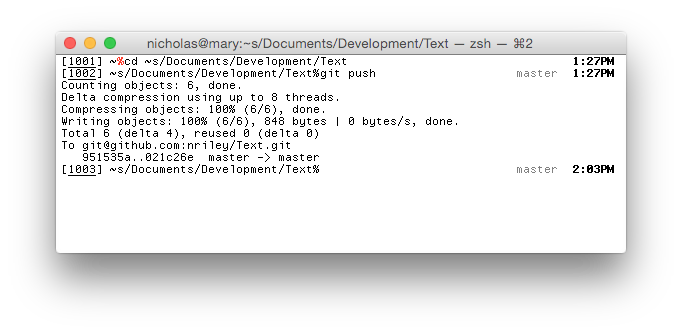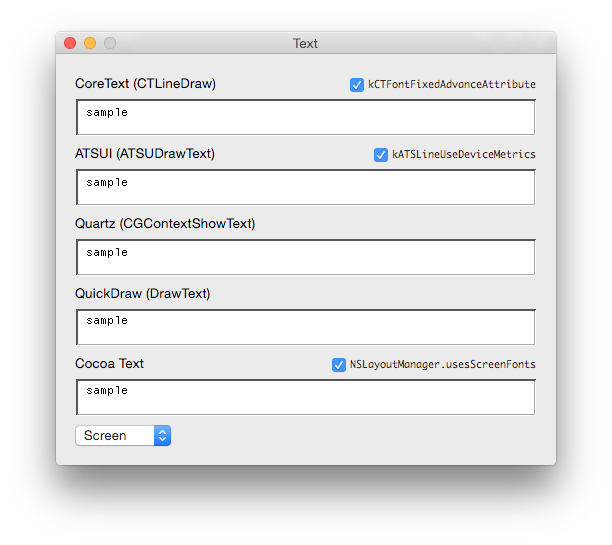Sunday, 1 November 2015
SGI screen fonts converted for OS X
The first Unix machines I sat at on a daily basis were the SGI Indys in the Berry Patch. IRIX’s proportional system font was Adobe Helvetica Oblique, which was nice; but its monospaced font was unique and home-grown, simply called screen. Here are a couple of screenshots I took in that environment nearly 20 years ago.
Screen remains the most readable monospaced bitmapped font I've ever used. It’s available in regular and bold weights, and a wide range of sizes: 7, 8, 9, 10, 11, 12, 13, 14, 15, 16 and 18 point. While I mostly use it in the 11 point size, the smaller sizes are terrific for fitting a bunch of log output in the corner of your screen.
After switching my desktop from Mac OS/Linux to Mac OS X in 2001, I initially used Monaco in both aliased and antialiased variants, but missed screen. I continued using screen in X11, running applications on the SGI O2 I then had on my desk, displaying remotely on my Power Mac G4.
In 2003 I used PfaEdit, now FontForge, to convert screen to a TrueType font so it’d work on OS X, and I have used it as my standard bitmapped font since. I would have made the conversions public earlier, but I was concerned about whether this would be a licensing violation. It turns out the SGI fonts were released under a MIT license a few months after I initially converted them back in 2003, but I didn’t notice until today. So, here are the fonts for you to download:
- Screen Medium (TrueType)
- Screen Bold (TrueType)
- Screen (Windows FON format, not my conversion but provided for convenience)
You may notice that these fonts look awful — with inconsistent horizontal and sometimes vertical spacing, even clipping — whenever you try to use them. Recent versions of OS X have been less kind to bitmapped fonts; here are some tips.
In Terminal, you can compensate for the font being squashed horizontally by adjusting the Character Spacing:

The result:

In the Emacs Mac port, you can disable antialiasing and ensure screen font metrics are used on a per-font basis. Here’s how I use Screen 11 if it’s installed, otherwise Menlo 12.
(cond ((eq window-system 'mac)
(cond ((x-list-fonts "Screen")
(create-fontset-from-ascii-font "Screen-11" nil "mac")
(set-fontset-font "fontset-mac" 'latin
"Screen-11:antialias=off:destination=1"))
(t
(create-fontset-from-ascii-font "Menlo-12" nil "mac")
(set-fontset-font "fontset-mac" 'latin
"Menlo-12")))
(setq default-frame-alist '((font . "fontset-mac")
(width . 80) (height . 80)
(background-color . "ghostwhite")))
(setq-default line-spacing 1) ; extra spacing
[...]
What you get:

In 2008 I built a demo app to demonstrate the various issues OS X had rendering this font, but I never actually filed any bugs. As long as I’m sharing the fonts I might as well share the app (source, binary). It uses a boatload of deprecated/removed API like QuickDraw and ATSUI, mostly to demonstrate how newer font APIs, such as the then-new CoreText, are worse at displaying bitmapped fonts than their older counterparts. You can click the checkboxes at right to see options you can use with the various APIs to try to fix the spacing:

Most Cocoa apps used to display the font without difficulty, but this changed in OS X 10.8 and later, which no longer perform screen font substitution by default. You can fix the font’s display by forcing the old behavior with NSFontDefaultScreenFontSubstitutionEnabled or NSLayoutManager.usesScreenFonts (which is deprecated in 10.11). These are discussed in the AppKit release notes (there’s no direct link but if you scroll up a little from the linked section you'll see it).
Bitmapped fonts are much less useful on a Retina display. A 5K iMac or equivalent is likely in my future when I replace my Mac mini, but not for a year or two as I just bought its current display this year. In any case, I may be posting this just as it’s about to become obsolete. Better late than never?
 12:47 PM
12:47 PM 15 Comments
15 Comments